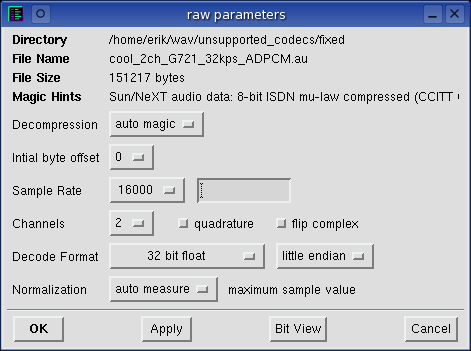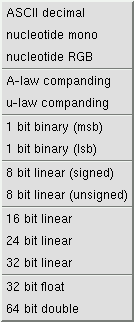 The raw parameters window is a method for importing non-standard or
raw headerless data files into baudline. It is a collection of parameter
fields that can be manually set to suit the specific data's sample rate,
channel layout, and format type. This window appears when a file is
opened from the open file window with the raw
file format option.
The raw parameters window is a method for importing non-standard or
raw headerless data files into baudline. It is a collection of parameter
fields that can be manually set to suit the specific data's sample rate,
channel layout, and format type. This window appears when a file is
opened from the open file window with the raw
file format option.

Directory, File Name, File Size
These fields are all self-explanatory.
Magic Hints
The classification type determined by the Unix file
command is displayed here. This is for informational purposes only which
may aid in the manual setting of the following raw parameters:
 Decompression
Decompression
The default auto magic case is similar to the
File Format option in the open file
window. If a file is losslessly compressed with an algorithm such as
gzip, bzip2, or flac, it is automatically decompressed prior to opening.
It is possible that random headerless binary data could have the magic bytes
at the start of the file that would incorrectly identify the file as being
wrapped in some lossless compression scheme. Or it could be the desire
of the user to analyze the raw data while it is in its compressed state.
In either case the decompression option can be manually set to OFF.
Initial byte offset
Byte alignment is important for
decode format types that are 16 or more bits long. An incorrect initial
byte offset will render valid data to be loaded as garbage. A useful
technique is to incrementally try offsets and hit the Apply button
until the data comes "in to focus." Starting with an initial byte
offset of zero and working up to one less than the number of bytes in
the chosen decode format is all that is necessary, since any
further offsets wrap around to the zero alignment condition. (example: with
the 32 bit float format try going from 0 ... 3)
Sample Rate
This option does not modify
the data in any way. It only affects the time (ms) and frequency (Hz)
rulers, and the measurement displays. If the option "custom" is chosen
then an integer or floating point custom sample rate can be entered in the
adjacent text box.
Channels
The multi-channel raw data samples
can be interleaved just like is common with standard audio formats such as
.aiff, .au, and .wav files. The selectable range of this option is from
one (mono) up to nine distinct channels. An interesting and educational
thing to try is to open mono audio data and set the channels option to a
value other than one. This has the effect of decimating the data without
proper anti-aliasing.
 Decode Format
Decode Format
Raw data is translated and read
into baudline using conversion routines set by this option. Most of the
decode formats are self-explanatory.
The ASCII decimal format reads space, comma, tab, or return delimited
integer, floating point, or scientific notation numeric text files.
The parsing routine is fairly robust and most numeric text files can be
opened without any problems. A two pass algorithm is used since ASCII
decimal data, by it's nature, has a variable width. This means an ASCII
decimal data file is read from the storage media twice. So when loading
very large data files there will be extra delay at the start before loading
commences and the load duration will be longer than it would if another
Decode Format was used. OpenOffice Calc data files that have been
saved in the text .csv format can be read into baudline with this setting.
The nucleotide mono and RGB format reads DNA basepair text data
like CACCGCTGAGAGACCCATACA into baudline. The mono version reads the data
in as a single channel. The RGB version
maps the basepairs into RGB color space in order to converse color coding in
the spectrogram view. Note that the nucleotide RGB version requires three
times the RAM and CPU usage than the mono version. So the mono version is
good for minimizing resource usage. File reading is fairly robust and ">" comment lines are allowed.
The A-law and u-law companding formats are logarithmic mappings
between 8 bit space and 13 or 14 bit space as described in the CCITT G.711
encoding and compression recommendation.
The 1 bit binary format can be either most (MSB) or least (LSB)
significant bit first. With (lsb) an 8 bit byte is assumed.
The 8 bit linear format can be either of the signed or unsigned
flavor. This corresponds to the "char" and "unsigned char" C language
data types.
The 16, 24, and 32 bit linear formats are all signed integers.
The 32 bit float and 64 bit double formats are standard IEEE 754
floating point numbers.
 Decode formats of 16 bits and larger
can have byte orders that are little endian (x86, flipped) or big
endian (most other microprocessors, the proper orientation). Note
that .wav files are little endian while .au and .aiff are typically
big endian. For raw files the endian
byte order will be the same as the native byte order of the machine
that created the file.
Decode formats of 16 bits and larger
can have byte orders that are little endian (x86, flipped) or big
endian (most other microprocessors, the proper orientation). Note
that .wav files are little endian while .au and .aiff are typically
big endian. For raw files the endian
byte order will be the same as the native byte order of the machine
that created the file.
 Normalization
Normalization
Baudline currently stores all internal
sample data in 16 bit format. This means that ASCII decimal, 24 and
32 bit linear, 32 and 64 bit float data all need to be scaled (normalized)
so that they fit into 16 bits without over flow. The auto measure
option uses the largest minimum or maximum value in the file and scales
that to be the 0 dB value. Power of two numbers in the range
from 1. to 2 billion (2^31) can be manually chosen as the maximum 0 dB value;
any values larger than this get clamped. Manually setting the
normalization value is sometimes useful when the auto measure mistakenly
uses a very large or very negative value that is representing some type of
header information such as sample rate or file size.
Note that auto measure utilizes a two pass algorithm. So for large
data files, manually setting the Normalization factor to a fixed value
will result in faster load times.
OK
This button opens the file with
the above raw conversion parameters and closes this window.
Apply
This button opens the file with
the above raw conversion parameters and unlike the OK button it keeps this
window open. This is useful for reducing mouse clicks and it lets the
user quickly experiment with different raw parameter settings.
Bit View
This button opens the bit view
window with the current file. Note that changing the decompression
option automatically updates the bit view display.
Cancel
This button closes the raw parameters
window. This could be useful if the user changes his/her mind or
as a way of closing after hitting the Apply button.
|


![]()